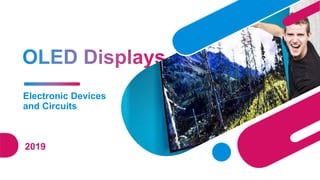
OLED Displays
- 2. • OLED (Organic Light Emitting Diodes) is a flat light emitting technology, made by placing a series of organic thin films between two conductors. When electrical current is applied, a bright light is emitted. OLEDs are emissive display that do not require a backlight and so are thinner and more efficient than LCD displays (which do require a white backlight). • OLED displays are not just thin and efficient - they provide the best image quality ever and they can also be made transparent , flexible, foldable and even roll able and stretchable in the future. OLEDs represent the future of display technology! • OLEDs are organic because they are made from carbon and hydrogen. There's no connection to organic food or farming 2
- 3. • OLED panels are made from organic materials that emit light when electricity is applied through them. Since OLEDs do not require a backlight and filters (like LCD displays do), they are more efficient, simpler to make, and much thinner - and in fact can be made flexible and even roll able. • The main component in an OLED display is the OLED emitter - an organic (carbon- based) material that emits light when electricity is applied. The basic structure of an OLED is an emissive layer sandwiched between a cathode (which injects electrons) and an anode (which removes electrons). 3
- 4. 4 • These terms relate to the driving method of the OLED display. A PMOLED (Passive- Matrix OLED) is limited in size and resolution (usually maximum resolution is around 128x128), but is cheaper and easier to make compared to an AMOLED (which uses an Active-Matrix). An AMOLED uses an active- matrix TFT array and storage capacitors. While these displays are more efficient and can be made large, they are also more complicated to make. • PMOLED displays are used in small devices or secondary displays while AMOLEDs are used in smartphones, tablets and TVs. Here's more information about the difference between PMOLED and AMOLED.
- 5. 5 • The leading AMOLED producer today is Samsung, who's making over 400 million displays a year, mostly smartphone-sized AMOLEDs (flexible and rigid). LG Display is the world's leading (and only) OLED TV panel maker, and LG is also starting now to produce small-sized flexible OLEDs. • OLED Opens Up the possibility to create - Foldable Displays - Rollable Displays - Stretchable Displays - Transparent OLEDs embedded in windows etc. - And many more we cannot even imagine today…
- 6. 6
